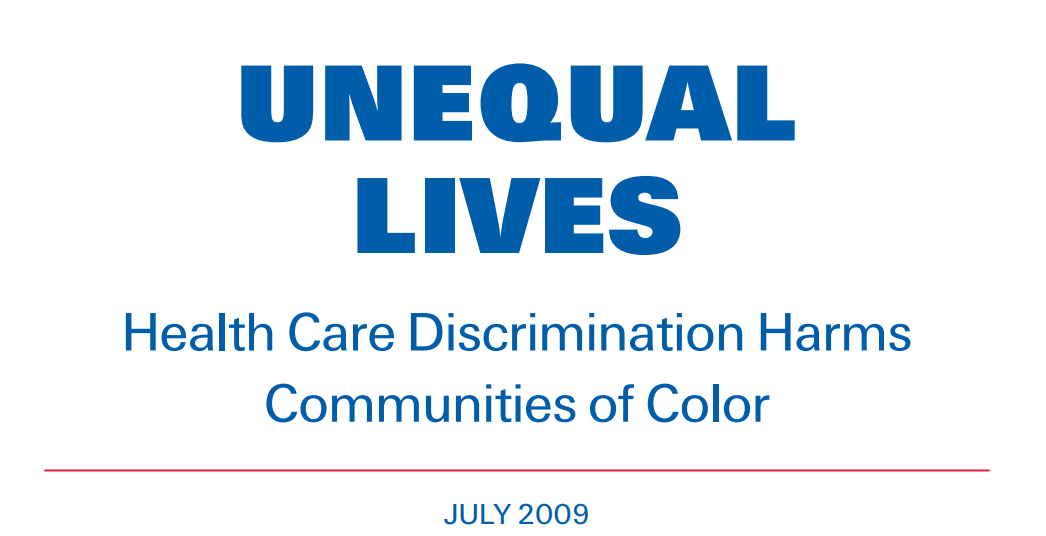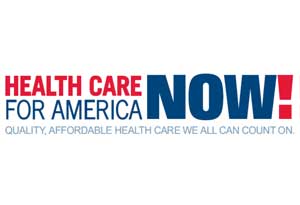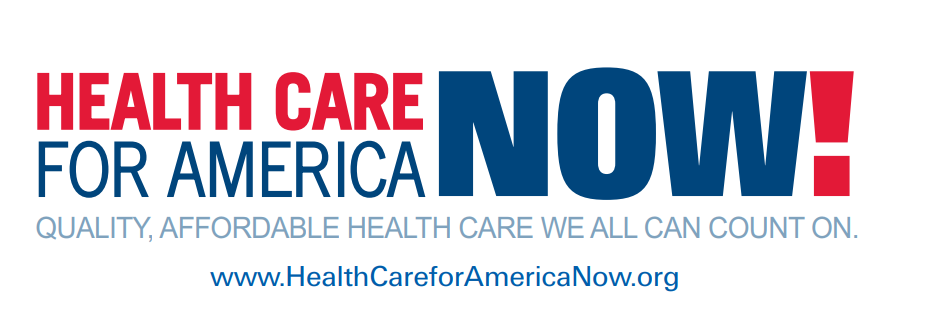- Like
- Digg
- Del
- Tumblr
- VKontakte
- Buffer
- Love This
- Odnoklassniki
- Meneame
- Blogger
- Amazon
- Yahoo Mail
- Gmail
- AOL
- Newsvine
- HackerNews
- Evernote
- MySpace
- Mail.ru
- Viadeo
- Line
- Comments
- Yummly
- SMS
- Viber
- Telegram
- Subscribe
- Skype
- Facebook Messenger
- Kakao
- LiveJournal
- Yammer
- Edgar
- Fintel
- Mix
- Instapaper
- Copy Link

Executive Summary
NO ONE HAS MORE AT STAKE in the political debate over how best to shape health care reform legislation than the 103 million people of color. After hundreds of years of unequal treatment in this country, communities of color are forced to continue accepting health care and health outcomes that fall short of the quality and availability of medical services provided to more advantaged groups.
Heart disease, diabetes, and cancer account for two-thirds of all U.S. health care costs. African
Americans, Latinos, Asian Americans, Native Americans and others who tend to live in neighborhoods with limited opportunities for healthful lifestyles have higher rates of all these diseases, and they fare worse in treatment. Were racial disparities absent from our society, the deaths of more than 880,000 African Americans would have been averted from 1991 to 2000, according to a recent analysis of mortality data. The implications for the country are profound when one considers the demographic trends at work today. The Census Bureau projects that 62 percent of the U.S. population will consist of people of color by 2050, when the U.S. population is expected to reach 439 million, up from 302 million today.
Compared to non-Latino whites, African Americans and Latinos are more likely to go without health care because they can’t afford it. A larger share of African Americans and Latinos lack a usual place of health care, and they are less than half as likely as whites to have a regular doctor. Low-income residents and people of color always score lower in measures of preventive health, such as frequency of cancer screenings and well-visit checkups. Inequities in health are accompanied by disparities in health insurance coverage. People of color have the highest rates of uninsurance. The lack of quality, affordable coverage makes these populations less likely to receive medical care and more likely to fall into poor health and die early, according to government analysts. Even when their insurance, income and diagnoses are comparable to those of whites, people of color with heart disease, cancer, diabetes, HIV/AIDS and other serious ailments often receive fewer diagnostic tests and less sophisticated treatment, according to a landmark 2002 report by the Institute of Medicine.
The effects are devastating to a multicultural society. They include shorter life expectancy, higher infant mortality rates, lower quality care, greater risk of diabetes, higher likelihood of death from cancer, less access to life-extending high-tech procedures, and increased risk of receiving undesirable treatments, such as limb amputations. In areas like the highly segregated city of Washington, D.C., the harsh effects of racial and ethnic health disparities are startling. The rates of infant mortality, asthma, high blood pressure, various cancers and numerous other health conditions are sharply higher in the predominantly African-American neighborhoods than in areas populated mostly by whites.
The medical establishment bears a major share of responsibility for the institutionalized racism
that has led to persistent health disparities in the U.S., and the American Medical Association, the largest physician group, has publicly acknowledged it. The negative impact of discrimination on the health of communities of color was profound and continues to this day, primarily because these actions left these populations with too few doctors to treat people of color in a culturally competent manner, according to the predominantly black National Medical Association. The extent of the health insurance industry’s contribution to health disparities is unknown because good data
are unavailable about the effects of insurers’ marketing practices, provider networks and treatment decisions made for people of color.
RECCOMENDATIONS
The health care reform legislation under consideration in Congress offers one of the best opportunities since the creation of Medicare and Medicaid in 1965 to change public policy and
erase persistent health disparities. Health Care for America Now (HCAN), a coalition of more than 1,000 organizations, urges Congress and the Obama administration to take advantage of this rare convergence of economic and political forces.
HCAN believes:
• Everyone should have access to an affordable benefit package that provides a defined set of comprehensive services to promote good health for all, including the millions who don’t speak English, in a linguistically and culturally competent manner.
• Coverage should be backed by adequate reimbursement rates and effective performance incentives that promote provider participation, change the inefficient behavior of doctors and hospitals and promote improved health for people of color.
• Substantial improvements in health and life expectancy will be achieved by addressing the social determinants of health, including a clean environment, occupational safety, safe neighborhoods and access to nutritious food.
• The nation must address chronic shortages of health professionals in communities of color and marginalized populations.
• Congress should implement mechanisms to support safety-net institutions and drive quality-improvement initiatives in all health care settings.
• Stakeholders and the public should be given good data by insurers and health care providers on race, ethnicity and ethnic subpopulation, socioeconomic position, primary language, age, gender and gender identity.
A high-performing health system must deliver quality care to everyone, regardless of race, ethnicity, sex, income, or any other demographic characteristic. A reformed and uniquely American system will be able to address a long history of discrimination in medical treatment by reorienting the way
doctors, hospitals, drug makers, medical device makers, insurance companies and government
programs provide care.
Acknowledgements
Health Care for America Now is grateful to the following people and organizations for their invaluable help in producing this report: Alex Lawson, Justin Berrier, Julie Chinitz, Dennis Osorio, Deepika Mehta, Esther Garcia, Darren Fenwick, Thomas M. Hunt, Seth Extein, Alex Thurston, Jonathan Flack, Monica Sanchez, Diane Archer, Shadia Garrison, Doneg McDonough, Sarah Shive, Dave Chandra, Lila Kalick, Margarida Jorge, Levana Layendecker, Lisa Goldstein, Regan Byrd, Laila Leigh, the Northwest Federation of Community Organizations, and the Institute for America’s Future.
VIEW THE PDF BELOW:
Read more about how WV CAG supports healthcare in our work here.





